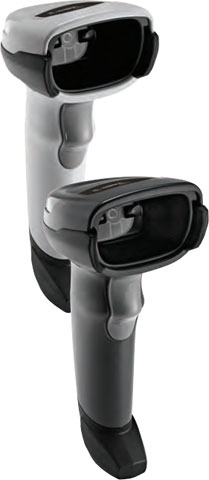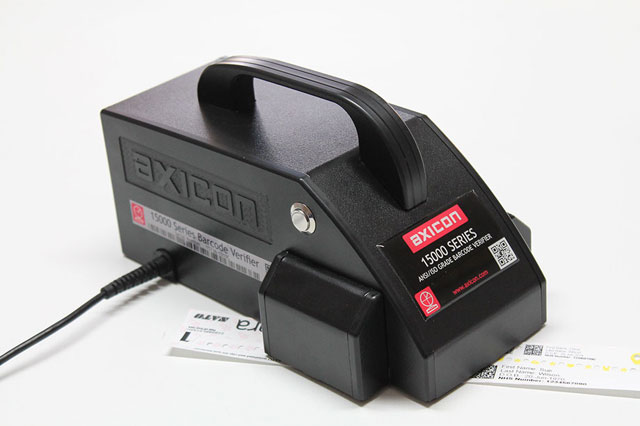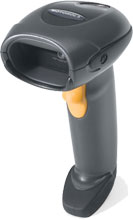Zebra’s DS2200, a Series of Handheld Imagers
 The DS200 Series are an affordable set of scanners that have an ease of use and management simplicity your business requires. The scanners come with default settings that are optimized for a majority of scanning applications allowing you to use the DS2200 scanners out of the box with no configuration needed. Just plug the scanner into your Point of Sale and the auto-host detect cables will automatically identify the interface and connect the imager for a simple and reduced setup time.
The DS200 Series are an affordable set of scanners that have an ease of use and management simplicity your business requires. The scanners come with default settings that are optimized for a majority of scanning applications allowing you to use the DS2200 scanners out of the box with no configuration needed. Just plug the scanner into your Point of Sale and the auto-host detect cables will automatically identify the interface and connect the imager for a simple and reduced setup time.
The Zebra set of scanners can scan all 1D and 2D barcodes printed or displayed on a customers’ mobile device. The DS2200 series comes in two options, the corded DS2208 and the cordless DS2278. With omni-directional scanning users never have to line up the scanner with the barcode for it to scan. Lastly with Zebra’s PRZM Intelligent Imaging users can capture barcodes regardless of condition even if they are dirty, scratched, damaged, or poorly printed.
DS2200 Features:
- Builds off the success of Zebra’s bestselling LS2208 1D scanner
- Point and shoot simplicity
- Adds 2D imaging at an outstanding value to any business
- Instant decoding with PRZM Intelligent Imaging
- Purpose-built to be easy to deploy,easy to use and easy to manage
- Corded & cordless models available
- Easy Integration with a Tablet-based POS
- Guaranteed full shift battery power
- Easiest pairing on the planet
- Easily Customize Settings with 123Scan
For any questions or a quote on any of your scanning needs contact us at Barcodes, Inc.
1D vs 2D Barcodes Explained
When it comes to tracking anything from basic inventory to patient data, choosing the right type of barcode can be the difference in how effective your system works. Everyone is familiar with the standard picket fence 1D linear barcodes but more and more applications are migrating to 2D barcodes. Both types of codes have their benefits and advantages and our specialists at Barcodes, Inc can help you determine which is the best fit for your needs.
Datalogic’s New QuickScan QD2131 Linear Imager
 Datalogic has announced their newest QuickScan product: the QD2131 1D linear imager. This is an entry level scanner with enhanced performance for general linear bar code scanning applications. When compared to the current QuickScan QD2130 imager, the new QD2131 imager brings to the table many enhancements in all aspects of scanning:
Datalogic has announced their newest QuickScan product: the QD2131 1D linear imager. This is an entry level scanner with enhanced performance for general linear bar code scanning applications. When compared to the current QuickScan QD2130 imager, the new QD2131 imager brings to the table many enhancements in all aspects of scanning:
- A longer reading range and depth of field (DOF)
- A wider scan angle and field of view (FOV)
- A brighter, crisper and longer scanning line
- Snappier bar code reading
- A more durable and sturdy look and feel
Additionally, the QuickScan QD2131 imager will have the updated QuickScan product family look and will be able to share the same stands and accessories as the QuickScan QD2400 imagers.
The Most Common Causes of Unreadable Barcodes
 Item identification and data acquisition through barcodes is critical to the function of automated operations, from ensuring that the correct components are used in the assembly of a smart phone to recording accurate patient data for samples in a laboratory. When poorly-marked or damaged barcodes result in “no-reads” or failures, loss of data can have disastrous effects on product integrity and corporate reputation – not to mention potential legal implications and serious risks to consumer welfare. Understanding the root cause of unreadable barcodes and using technology appropriately to prepare for or resolve these issues is simple to do and it can mean the difference between success and failure in automation. This white paper describes potential solutions for the most common causes of unreadable barcodes, including:
Item identification and data acquisition through barcodes is critical to the function of automated operations, from ensuring that the correct components are used in the assembly of a smart phone to recording accurate patient data for samples in a laboratory. When poorly-marked or damaged barcodes result in “no-reads” or failures, loss of data can have disastrous effects on product integrity and corporate reputation – not to mention potential legal implications and serious risks to consumer welfare. Understanding the root cause of unreadable barcodes and using technology appropriately to prepare for or resolve these issues is simple to do and it can mean the difference between success and failure in automation. This white paper describes potential solutions for the most common causes of unreadable barcodes, including:
- Low Contrast
- Quiet Zone Violations
- Improper Reading Position
- Print or Mark Inconsistency
- Damage or Distortion
Axicon Launches New 15000 Linear & 2D Barcode Verifier

Axicon has announced the launch of a new 1D/2D barcode verifier. The 15000 verifier has been specifically designed to verify both linear and 2D barcodes.
The 15000 is a camera based verifier which is powered solely from a USB port. Its typical application includes retail point of sale barcodes like UPC/EAN and also 2D barcodes such as Datamatrix, QR etc. The 15000 verifier meets the applicable ISO/ANSI/GS1 verification standards.
Finding the Right Barcode Scanner – What Makes Them Different?

Selecting a barcode scanner may seem like a simple enough task at first glance but given the range of barcodes and how they are used today, it can quickly become a challenge to find the right one. Most scanners today are more than capable of reading well printed barcodes on a typical paper label. That said, uses for barcodes have expanded well beyond basic labels and many specialized scanners are available to meet the needs of specific applications. In the following we’ll cover some key features to consider when trying to select the best fit scanner for your needs.
1D or 2D – Printed or Electronic
Probably the most crucial first step in selecting a scanner is determining what kind of barcodes you will be reading. The traditional picket fence style 1D barcodes are still the most commonly used and are often printed on a label but you will find the use of 2D matrix style codes much more common today. Likewise, you may not just be reading barcodes on a printed label as more applications are embracing scanning off of smartphone screens or from codes directly etched/molded into a product. In the case of simple 1D barcodes on a label, your standard laser of linear imager will readily meet your needs. For 2D barcodes or applications reading from not printed surfaces, a full 2D imager will be needed to properly scan the code. 2D imagers are more costly but their main advantage is that they can essentially omnidirectionally read any barcode from almost any surface.
Ensure Scanning Flexibility with the 2D Upgradable Honeywell Voyager 1400g

Why should you have to choose between buying a 1D scanner today and risk replacing it with a 2D scanner in a few years, or paying more for a 2D scanner today when you may never need to read 2D? Start out with 1D performance at 1D pricing and upgrade to what you need, when you need it, for much less than purchasing a new scanner.
Built on the platform of Honeywell’s world-renowned Voyager series of hand-held linear scanners, the Voyager 1400g delivers omnidirectional reading of linear bar codes, plus the ability to affordably upgrade the device license to enable PDF and 2D bar code scanning—at the time of purchase or as scanning needs evolve. Performing at speeds that are comparable to laser-based scanners, the versatile and reliable Voyager 1400g can be customized to meet current and future scanning needs, lowering the total cost of ownership.
For assistance finding the right Honeywell scanner for your needs, contact us at Barcodes Inc.
Motorola LI2208 : The Next Generation 1D Scanner
Building on the long standing popular design of the LS2208 series, the new LI2208 brings more features and greater reliability to your daily operations. With a new linear imager vs the previous laser scan engine, the LI2208 reads any 1D barcode be it on paper, a mobile phone screen, or even high density codes.
The LI2208 is a cost effective solution to increase productivity and effectiveness in any scanning application while expanding the possible implementations of barcodes in your business.
Evaluating Barcode Reading Technologies: Laser vs. Imager

Choosing the right barcode reading technology is fundamental to achieving optimal performance from a data collection solution. As new symbologies and technologies are developed, the choices are more varied than ever. There has been much debate on the merits of laser-based and camera-based barcode readers, and in fact, some have asserted that only image-based readers should be considered for new automation applications.
Should laser barcode scanners be considered “obsolete” technology and are imagers (camera-based readers) the only viable technology for today’s applications? While imagers have seen increased use due to the growing adoption of 2D symbols such as Data Matrix, laser scanners still set the standard for accurate, high speed barcode reading in many applications. The optimal barcode reading solution will be dictated by the specific requirements of an application.




